Young Leopard Geckos mostly eat the same food as adults. They do need smaller prey, however, and need feeding a little more often…
Last updated on February 1st, 2023 at 09:26 am
Juvenile Leopard geckos are almost exclusively insectivorous, enjoying a range of feeder insects that include hornworms, Dubia roaches, and crickets. Unlike some larger species, the babies eat a similar diet to the adults. They just need prey that is small enough to swallow, and that is safe for them to tackle.
In this article, we’ll take a closer look at what young Leopard Geckos eat, how often they eat, and the importance of vitamin supplementation. After all, getting their diet right is an essential part of caring for Leopard Geckos.
What do baby leopard geckos eat?
Leopard geckos exclusively eat bugs, this makes their diet diverse keeping them entertained.
Throughout the life of leopard geckos, their diet doesn’t change much. This is why, when it comes down to feeding a baby leopard gecko, it’s not about the type of bug, it’s the portion in which you are feeding them.
As a general rule of thumb, keep the size of their feeder bug as big as the distance between the gecko’s eyes.
Foods for leopard geckos are the same as those for adults – but at smaller sizes. They include:
- Small Crickets
- Dubia Roach nymphs (before they get wings)
- Small Mealworms
- Small Hornworms
- Small Superworms
- Black soldier fly larvae
Out of these options, Dubia Roaches, Mealworms, Superworms, and Crickets are the most widely available, but can grow too large to be a suitable food for babies. Make you provide subadult prey if these are your preferred choices. Also, never leave uneaten roaches or crickets with your baby Leopard Gecko, as they can start to nibble it if they realise it isn’t going to eat them.
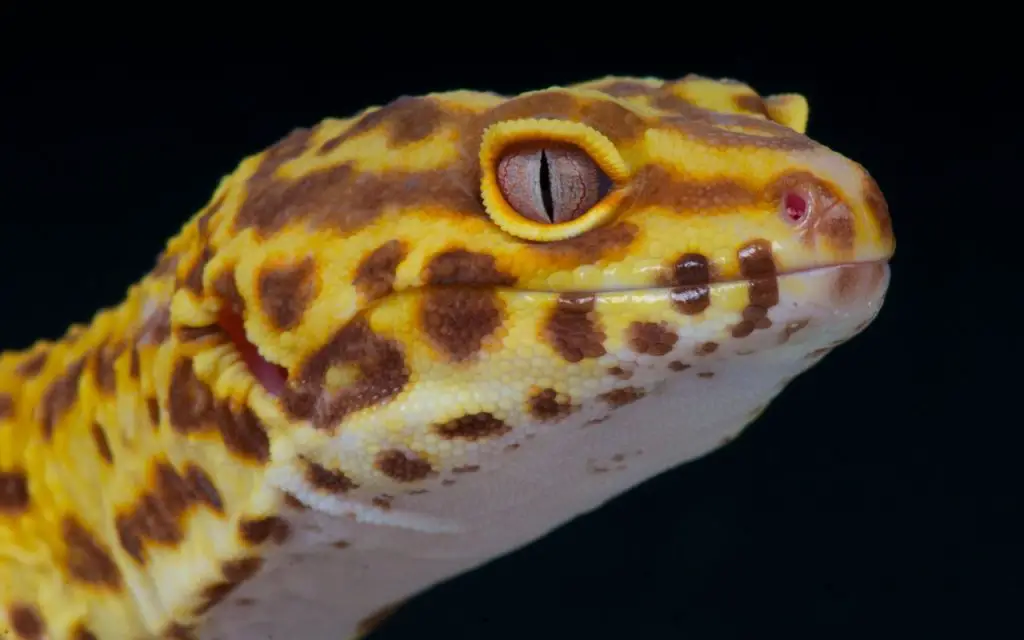
Can I feed my leopard gecko wild insects?
You must never, ever feed your Leopard Gecko wild insects, regardless of its age. Wild crickets, caterpillars and other bugs have several things in them that can harm or kill your Gecko. These include infectious diseases, parasitic worms, harmful protozoa, insecticides and herbicides.
To be honest, it would be really convenient (and cheap) if we could just catch food for our pets. To risks are just too high, though. You should always source food from a dedicated pet supplier.
Do baby geckos drink water?
Yes, baby geckos drink water. More often than not, leopard geckos gather most of their water through their food but this should not stop you from providing your pet leopard gecko with fresh water.
You have to develop a consistent source of water for your leopard gecko & change it every 7 days.

How often should I feed my baby leopard gecko?
Juvenile leopard geckos are a couple of months old or less. You need to feed them every day when first hatched, and for the first few weeks. Then every other day, depending on their appetite.
If they finish all of their food, you can try feeding them again the next day. Once they reach a decent size, say 3 to 4 inches (7 to 10cm), you start reducing the frequency to twice a week, then once or twice a week when they are fully grown.
At this point it’s important to mention that Leopard Geckos store fat in their tail. If it’s tail is fat, it’s definitely getting enough food, but if it’s very thin it is underfed or sick. Always keep an eye on this. Baby Leopard Geckos naturally have thinner tails than adults, but they should be stick-like.
To feed your juvenile leopard gecko, give them one session to finish all their food. The session should usually last up to 10 minutes. If they don’t finish, don’t leave prey in their enclosure. Remove it all and try again next time.
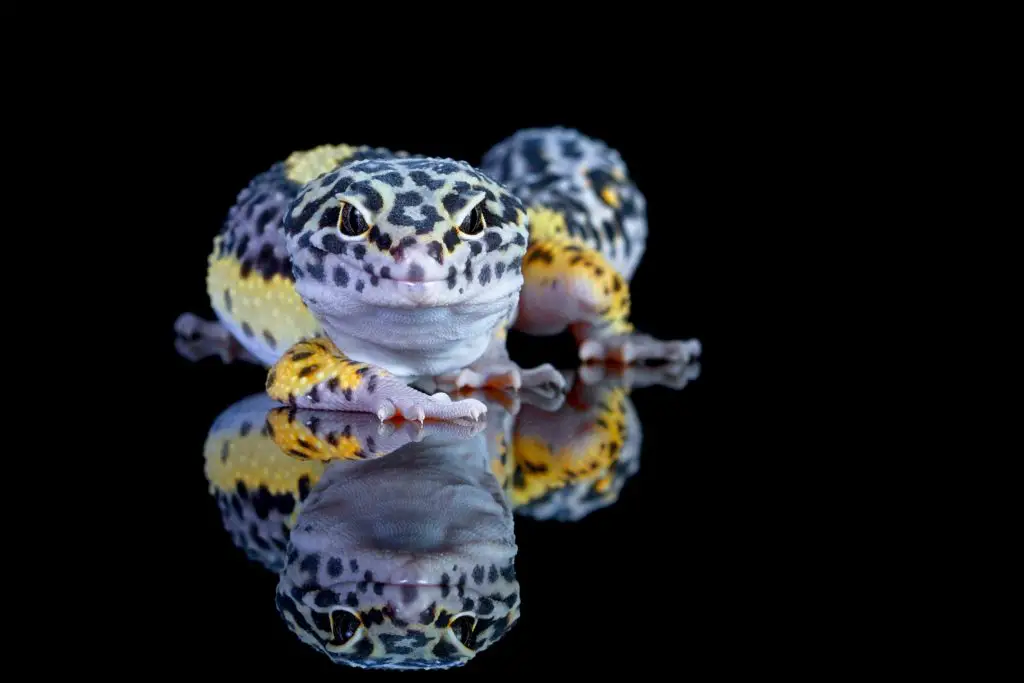
What do adult leopard geckos eat?
Adult Leopard geckos have a diverse diet of arthropods both in the wild and captivity. It is also speculated that they eat some vertebrate prey in the wild, though conclusive studies are hard to come by. Personally, I’ve always found them to have a strong invertebrate preference, though they will occasionally take pinkie mice.
The diet in captivity can consist of any of the following:
- Crickets
- Mealworms
- Waxworms
- Hornworms
- *Dubia Roaches
- Superworms
- Black soldier fly larvae
*Dubia Roaches are particularly nutritious – it’s good if you can include these from time-to-time.
While the leopard geckos’ meal doesn’t change much, the prey size varies according to the distance between their eyes. Generally, most breeders agree that the prey should be no bigger than this distance.
The frequency of feeding the leopard geckos also changes according to their age.
You do not want to feed an adult every day, neither you want to skip a couple of days to feed a youngling. The juveniles need to be fed every day or every other day. Adult leopard geckos eat every 2-3 days, or once a week if they are quite old and plump.

What are leopard geckos’ favourite snacks?
Most Leopard Geckos aren’t too picky, and seem to enjoy pouncing on crickets and mealworms. This is pretty convenient, given that these two foods are widely available and cheap. There are foods that they really enjoy a lot and seem to consider “treats”, though.
Leopard geckos love the following worms:
- Hornworm
- Waxworm
It’s worth noting that Hornworms are particularly high in water content, despite being low in fat. Feeding these can help keep your pet hydrated if it is stubborn about drinking water.
It’s also worth noting that Hornworms are perfectly healthy, they’re just more expensive and less widely available. You can feed them regularly if you can get them.
Waxworms, on the other hand, are quite fatty and should only ever be an occasional treat really.

How do I know if my leopard gecko is happy?
Here are the signs that your leopard gecko shows when it is happy:
- They are having their normal sleeping cycle
- When they are active, they are doing many kinds of activities. From exploring to digging.
- They are eating regularly
- Being easy-to-handle
- Shedding their skin regularly
- Pooping regularly at the same spot
To keep your leopard gecko happy, you have to add things for the gecko to do inside their tank. This means a few obstacles to climb over, and two to three different caves to hide/explore.
Also, make sure the size of the tank is also right. As a general rule of thumb, you can keep an adult leopard gecko inside a 20-gallon tank and a youngling inside a 10-gallon one.
What vegetables can leopard geckos eat?
Leopard geckos are insectivorous which means they only eat insects. Leopard geckos lack the ability to digest vegetables, so the only time they’ll ever try to eat vegetables is when they are starving or curious.
Unlike Bearded Dragons and Iguanas, Leopard Geckos never need vegetables to stay healthy. Their metabolism is perfectly adapted to invertebrate prey for their whole diet. All you need to do is make sure that their prey is dusted in multivitamins and a calcium supplement on a regular basis.
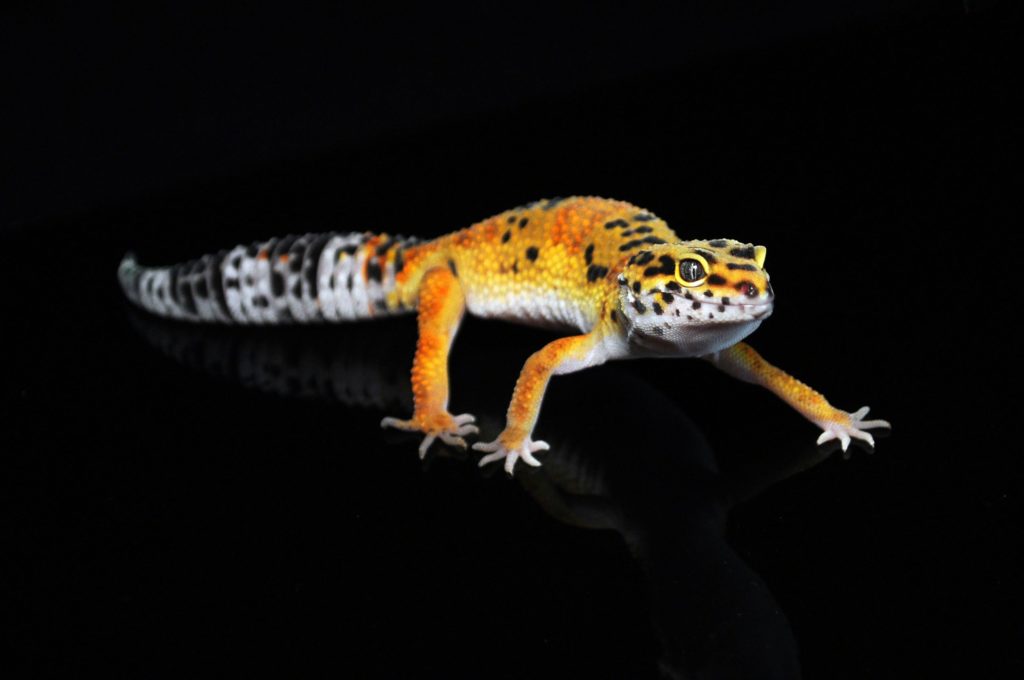
What fruits can leopard geckos eat?
Leopard geckos cannot eat fruits. Unlike other geckos, leopard geckos do not possess the ability to digest fruits. The only time your leopard gecko will ever try to eat a fruit is when it is starving or if it is curious. Usually a bite is all it takes before they spit it out again.
How often do leopard geckos eat?
Leopard Gecko feeding frequency should differ according to its age. Take a look at our chart:
| Hatchling | Every single day. You’ll need to take extra care of them. |
| Juvenile | Leopard geckos that are 2-3 months old are considered ‘juvenile’. You’ll need to feed a juvenile leopard gecko every other day. |
| Adult | Adult leopard geckos do not need much care, you’ll only need to feed them every 2-3 days. Matter of fact, you should not feed an adult leopard gecko every single day as it can lead to health complications. |
| Older adults | Once or twice a week, depending on their appetite and how fat their tail is. |
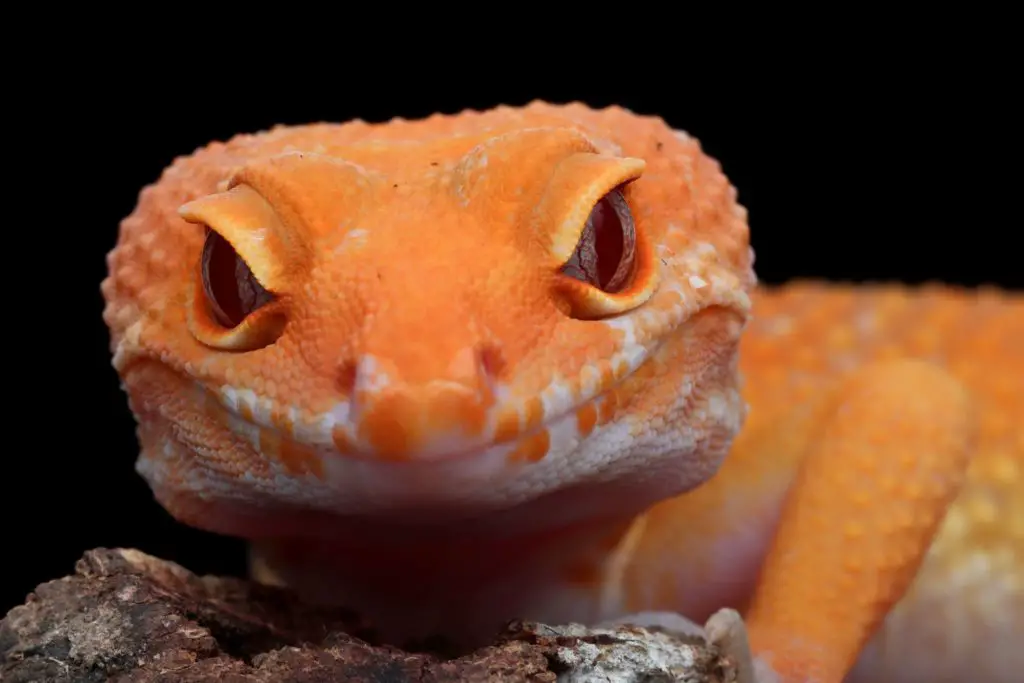
The importance of vitamin and mineral supplements
On top of their regular diet, you must give your Leopard Gecko a multivitamin supplement, and a calcium supplement. This is necessary because captive-raised insects have a low calcium content, poor calcium-to-phosporous ratio, and sometime poor vitamin content.
When it comes to calcium supplements, there are two kinds: with vitamin D3 and without. If you provide UV lighting for your gecko, then it only needs a calcium supplement without vitamin D3.
If you do not provide UV lighting, then give your geckos a Calcium with vitamin D3 supplement. Either method is fine, so long as your pet is getting the vitamin D3 for calcium metabolisation from somewhere to maintain a healthy skeleton.
Make sure you are gut-loading the insects (feeding them supplements) or dusting them with the supplements before feeding them to the gecko.
How often should I dust leopard gecko food?
In captivity, leopard gecko requires supplement and without them, it can lead to major health issues. Dusting your leopard gecko food differs according to their age.
| Age | Calcium powder | Multivitamins |
| Hatchling | 5 days a week | 2 days a week |
| Juvenile | 2 to 3 days a week | 1 day a week |
| Adult | 6 to 8 times a month | 2 to 3 times a month |
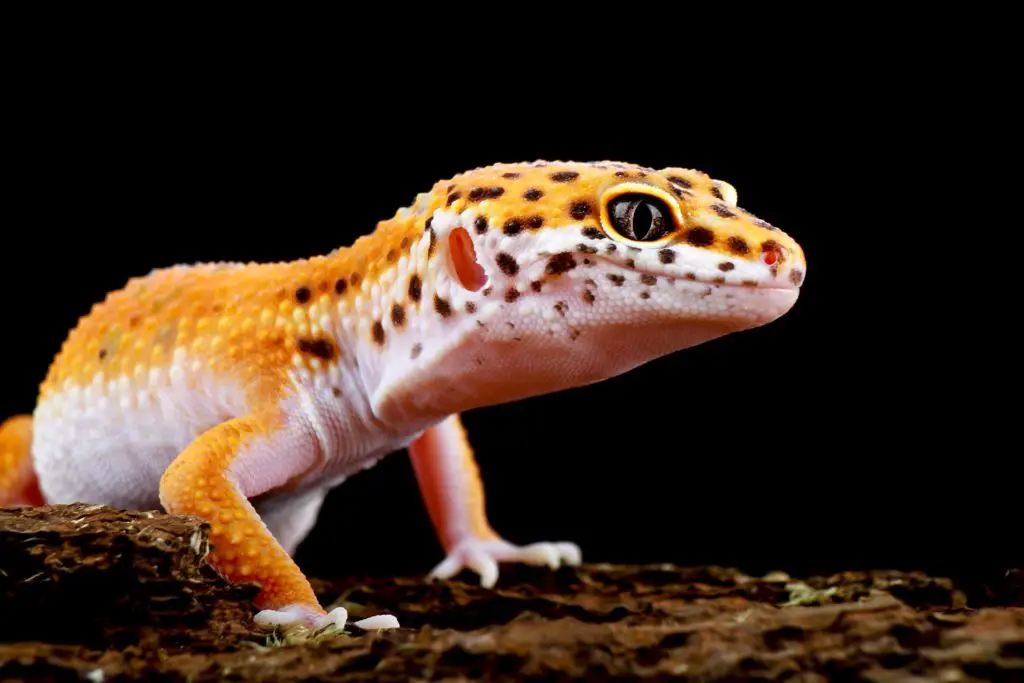
FAQ relating to what do young leopard geckos eat
How do you feed a juvenile leopard gecko?
Juvenile leopard geckos are crepuscular meaning they are most active between dawn and dusk. You should feed them at night, so you don’t disrupt their normal sleeping cycle.
Feeding them every other day is also important. You should not feed juvenile leopard geckos every single day, only freshly hatched babies.
Although leopard geckos love to eat, feeding them more than they need can build up fat in their body. Excessive fat can lead to obesity and obesity can lead to severe health complications.
Make sure that the size of the bugs you are feeding them is not bigger than the distance between their eyes. Do not add Waxworm to their standard diet unless it’s a treat. Waxworms are high in fat and can make a gecko obese.
What do young geckos eat?
Young leopard geckos eat everything that adult leopard geckos eat, just in smaller sizes. Make sure you are dusting them with supplements before giving them to the gecko. Recommended supplements include as Calcium, Calcium D3 & multivitamins. Calcium with Vitamin D3 should be used if you do not provide UV lighting for your gecko.
When should I feed my baby leopard gecko?
As previously, briefly, mentioned that leopard geckos are most active during dawn and dusk. This is the perfect time for you to feed your baby leopard gecko. Again, you want to make sure that the portions are not too big and remove any uneaten food.
Sometimes, it’s easier to provide mealworms in a small bowl. This way they can’t escape and annoy your leopard gecko, though obviously this isn’t possible with crickets.
What can I give my leopard gecko as a snack?
Usually, you do not want to feed your gecko snacks. Giving your geckos a chance to eat in one session of 10 minutes is usually the best way.However, if you feel like treating your gecko, you can feed them Waxworms or Hornworms.
Your gecko will love these worms and they’ll easily become one of its favourites. Again, you do not want to get your gecko hooked on them. Keep things moderate and provide your gecko with a balanced diet.

